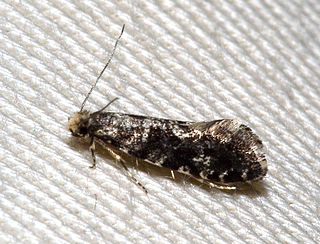
Tineidae is a family of moths in the order Lepidoptera described by Pierre André Latreille in 1810. Collectively, they are known as fungus moths or tineid moths. The family contains considerably more than 3,000 species in more than 300 genera. Most of the tineid moths are small or medium-sized, with wings held roofwise over the body when at rest. They are particularly common in the Palaearctic, but many occur elsewhere, and some are found very widely as introduced species.

Utetheisa is a genus of tiger moths in the family Erebidae. The genus was first described by Jacob Hübner in 1819.

George Talbot FES was an English entomologist who specialised in butterflies. He wrote about 150 scientific papers, the majority being primarily systematic, consisting of the description of new species or the revision of various genera. He was also responsible for the curation and preservation of the Joicey collection of Lepidoptera prior to its accession by the Natural History Museum.
Paul Mabille was a French naturalist mainly interested in Lepidoptera and botany.

Emmelia trabealis, the spotted sulphur, is a moth of the family Noctuidae. The species was first described by Giovanni Antonio Scopoli his 1763 Entomologia Carniolica.

Feliniopsis is a genus of moths of the family Noctuidae.
Megalonycta is a genus of moths of the family Noctuidae. The genus was erected by Pierre Viette in 1965.
Pseudelaeodes is a genus of moths of the family Noctuidae.

Stenodrina is a genus of moths of the family Noctuidae.
Tunocaria is a genus of moths of the family Noctuidae. There is only one species in this genus, Tunocaria rubiginosa, that is known from Madagascar.
Leucania herrichii is a species of moth in the family Noctuidae. It was described by German entomologist Gottlieb August Wilhelm Herrich-Schäffer in 1849 as Mythimna herrichii. It can be found in Bulgaria, Croatia, Cyprus, Egypt (Sinai), Greece, Iran, Israel, Italy (Sicily), Jordan, Lebanon, Palestine, Syria, Turkey, and Turkmenistan. Adults have a wingspan of approximately 30–36 mm (1.2–1.4 in), and the larvae likely feed on grasses.
Max Gaede was a German engineer and entomologist of international fame who described several hundred of new species of Lepidoptera, mainly African Noctuidae.
Louis Beethoven Prout (1864–1943) was an English entomologist and musicologist.
Georges Rousseau-Decelle was a French entomologist.
Homoeosoma striatellum is a species of snout moth in the genus Homoeosoma. It was described by Harrison Gray Dyar Jr. in 1905. It is found in North America, including Arizona, California and Nevada.
Alexey Nikolaievich Diakonoff, also transliterated as Alexej Nikolajewitsch Diakonoff, was a Russian–Dutch entomologist who specialised in Microlepidoptera.
Emilio Berio was an Italian entomologist and lawyer.

Chlosyne californica, the California patch, is a butterfly of the family Nymphalidae found in the Southwestern United States and Mexico. It lives in desert washes and canyons in regions between southern Nevada south to southwestern Arizona, southeastern California, Baja California and Sonora.
Charles Boursin (1901–1971) was a French entomologist, born into a comfortable bourgeois Catholic family in Nantes. Having had a German governess, he spoke German from his earliest days and remained "perfectly" bilingual in both during his lifetime. He also spoke Hungarian and Russian. Despite his formal humanist education he showed an early interest in the natural sciences.






